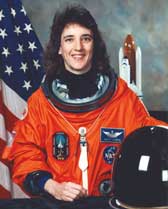 |

|
|
||||
|
Nancy Jane Currie, Ph.D. (Lieutenant Colonel, USA) NASA BIOGRAPHY Posted: January 7, 2002 PERSONAL DATA: Born December 29, 1958, in Wilmington, Delaware, but considers Troy, Ohio, to be her hometown. Married to David W. Currie. They have one daughter. She enjoys weight lifting, running, swimming, scuba diving, and skiing. EDUCATION: Graduated from Troy High School, Troy, Ohio, in 1977; received a bachelor of arts degree in biological science from Ohio State University, Columbus, Ohio, in 1980, a master of science degree in safety from the University of Southern California in 1985, and a doctorate in industrial engineering from the University of Houston in 1997. ORGANIZATIONS: Member of Army Aviation Association of America, Phi Kappa Phi, Ohio State University and ROTC Alumni Associations, Institute of Industrial Engineers, and Human Factors and Ergonomics Society. SPECIAL HONORS: Arts and Sciences Award for Scholarship, Ohio State University (1980), Distinguished Graduate of the Army Air Defense Artillery Officer Basic Course (1981), Honor Graduate of the Army Rotary Wing Aviator Course (1982), Honor Graduate of the Army Aviation Officer Advanced Course (1986), NASA Flight Simulation Engineering Award (1988), NASA Space Flight Medal (1993, 1995, 1998), Defense Superior Service Medal (1993), Ohio Veteran's Hall of Fame (1994), Troy, Ohio Hall of Fame (1996), Ohio State University Army ROTC Hall of Fame (1996), Silver Order of St. Michael, Army Aviation Award (1997). EXPERIENCE: Following graduation, Nancy served as a neuropathology research assistant at the Ohio State University College of Medicine. She was commissioned as a second lieutenant in the U.S. Army in July 1981, and attended the Air Defense Officer Basic Course and the United States Army Aviation School. Following flight training she was assigned to Fort Rucker, Alabama as a helicopter instructor pilot. She also served as a section leader, platoon leader, and brigade flight standardization officer for all phases of rotary wing flight, including combat skills and night vision goggle operations. A Master Army Aviator, she has logged 3,900 flying hours in a variety of rotary wing and fixed wing aircraft. NASA EXPERIENCE: Currie was assigned to NASA Johnson Space Center in September 1987 as a flight simulation engineer on the Shuttle Training Aircraft, a complex airborne simulator which models flight characteristics of the Orbiter. Selected by NASA in January 1990, she became an astronaut in July 1991. Her technical assignments within the Astronaut Office have included flight crew representative for crew equipment; lead for the Remote Manipulator System (RMS), and spacecraft communicator (CAPCOM), providing a communications interface between ground controllers and flight crews. She also served as Chief of the Astronaut Office Robotics Branch. A veteran of three space flights, she has logged over 737 hours in space. She was a mission specialist on STS-57 in 1993, STS-70 in 1995, and STS-88 in 1998 (the first International Space Station assembly mission). She is assigned to STS-109 scheduled for launch late in 2002. The STS-109 mission will upgrade and service the Hubble Space Telescope. SPACE FLIGHT EXPERIENCE: On her first spaceflight, STS-57, Dr. Currie served as the flight engineer. This mission launched from the Kennedy Space Center, Florida, on June 21, 1993, and returned on July 1, 1993. The primary objective of this flight was the retrieval of the European Retrievable Carrier satellite (EURECA) using the RMS. Additionally, this mission featured the first flight of Spacehab, a commercially-provided middeck augmentation module for the conduct of microgravity experiments, as well as a spacewalk by two crew members, during which Currie operated the Shuttle's robotic arm. Spacehab carried 22 individual flight experiments in materials and life sciences research. The STS-57 mission was accomplished in 155 orbits of the Earth in 239 hours. Currie also served as the flight engineer on STS-70, which launched from the Kennedy Space Center, Florida, on July 13, 1995, and returned July 22, 1995. The five-member crew aboard Space Shuttle Discovery deployed the final NASA Tracking and Data Relay Satellite to complete the constellation of NASA's orbiting communication satellite system. The crew also conducted a myriad of biomedical and remote sensing experiments. During this 8 day 22 hour mission, the crew completed 142 orbits of the Earth, traveling 3.7 million miles. In December 1998, Currie served as the flight engineer on STS-88, the first International Space Station assembly mission. The primary objective of this 12-day mission was to mate the first American-made module, Unity, to the first Russian-made module, Zarya. Dr. Currie's primary role was to operate the Shuttle's 50-foot robotic arm to retrieve Zarya and connect the first two station segments. Two crewmembers performed a series of three space walks to connect electrical umbilicals and to attach hardware to the exterior structure for use during future EVA's. Dr. Currie also operated the robot arm during the space walks. During the mission the STS-88 crew ingressed the International Space Station to complete systems activation and installation of communication's equipment. They also deployed two satellites, Mighty Sat 1 and SAC-A. The mission was achieved in 185 orbits of the Earth in 283 hours and 18 minutes.
|

|